| |
Giorgio de Chirico was one of the most influential
artists of the Twentieth Century. His Metaphysical art was an
inspiration to many artists, including those working with
Magic Realism, Surrealism and Fantastic Realism.
While at the Academy of Fine Arts in Munich, De Chirico
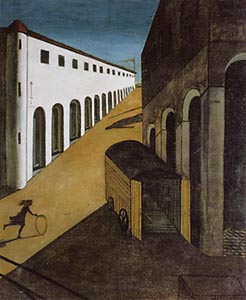 studied
and admired the art of Arnold Boecklin and Max Klinger. But he
was even more influenced by the philosophers Nietzsche and
Arthur Schopenhauer. After moving to Italy in 1909, he began
painting cityscapes which included enigmatic elements and
personal symbols. This first phase of his paintings is called
the Piazza d'Italia series. In 1914, he began another series of
paintings in which ambiguous and diverse iconography was
introduced. Included in these paintings were mannequin-like
figures, boxes, maps, architectural fragments and
a sundry of other objects. Juxtapositions and groupings of
these various articles, together
with distortions in perspective helped to give this art its captivating
allure. studied
and admired the art of Arnold Boecklin and Max Klinger. But he
was even more influenced by the philosophers Nietzsche and
Arthur Schopenhauer. After moving to Italy in 1909, he began
painting cityscapes which included enigmatic elements and
personal symbols. This first phase of his paintings is called
the Piazza d'Italia series. In 1914, he began another series of
paintings in which ambiguous and diverse iconography was
introduced. Included in these paintings were mannequin-like
figures, boxes, maps, architectural fragments and
a sundry of other objects. Juxtapositions and groupings of
these various articles, together
with distortions in perspective helped to give this art its captivating
allure.
The art which De Chirico produced between 1909 and 1919 is
referred to as his Metaphysical Period. It unfolded in two
phases, the earliest lasting from 1910 to 1914 and including
many of his so-called Piazza works. In this period the
compositions are metaphorical and classically influenced,
informed by Boecklin and Max Klinger. The second phase lasted
from 1915 to 1919 and covered mostly interiors which
incorporated a plethora of objects including architectural
drafting instruments, mannequins and furniture. The first
phase is related to Magic Realism, and the second is more
closely associated with Surrealism.
In 1917
he met Carlo Carra and together with Filippo de Pisis, Giorgio
Morandi and Mario Sironi the form the Scuolo Metafisica.
However, in 1919, on seeing works by Titian, De Chirico had a
revelation and began working in the style of the Old Masters.
From this time until his death, his work would concern itself
with both the Metaphysical style and the Return to Order, a
revival of Classicism.
For De Chirico the object was a theatrical prop. There is no
doubt that the Metaphysical paintings had a significant role
in the emergence of Magic Realism. It is likely that Franz Roh
also had De Chirico in mind when he spoke about Magic Realism
and a "renewed delight in real objects", and added that this
new art seemed to offer "a calm admiration of the magic of
being; a question of representing before our eyes, in an
intuitive way, the fact, the interior figure, of the exterior
world". Compare Roh's comments to De Chirico's statement
"To have original, extraordinary and perhaps even immortal
ideas, one has to isolate oneself from the world for a few
moments so completely that the most commonplace happenings
appears to be new and unfamiliar".
| |
|
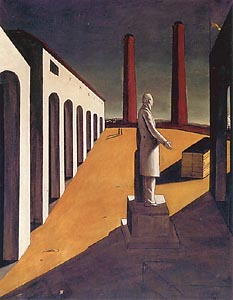 |
|
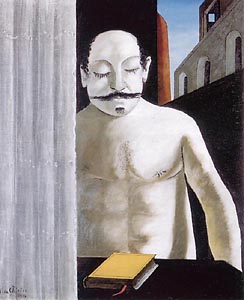 |
|
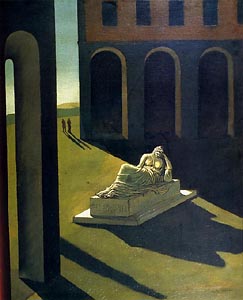 |
| |
|
The Enigma of a Day I (1914) |
|
The Child's Brain (1914) |
|
Melancholy (1912)
|
| |
|
 |
|
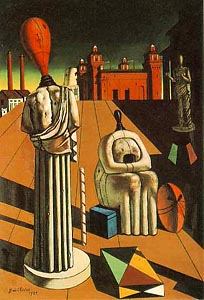 |
|
 |
| |
|
The Song of Love (1914) |
|
The Disquieting Muse
(1917-18) |
|
The Dream of Tobias (1917) |
|
|
|
| |
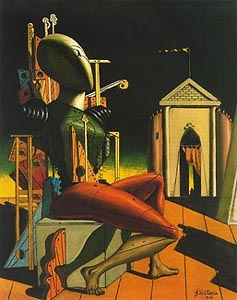 |
|
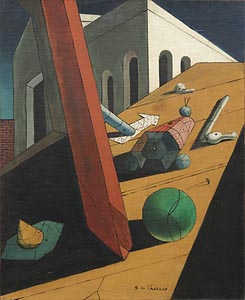 |
|
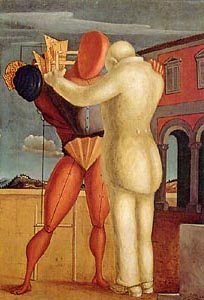 |
|
| |
The Prophet (1916) |
|
The King's Evil Genius (1914-15) |
|
The Prodigal Son (1922) |
|
| |
|
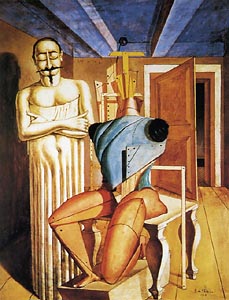 |
|
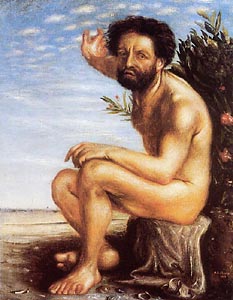 |
|
%201b.jpg) |
| |
|
The Apparition of the Ghost (1917-18) |
|
Ulysses (1922) |
|
The
Vexations of the Thinker (1937) |
|
|
| |
|
 |
|
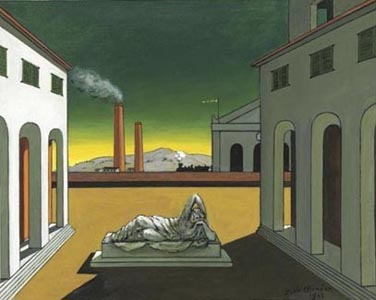 |
| |
|
Piazza d'Italia (1913) |
|
Meditation
at Dusk (1943) |
| |
 |
|
|
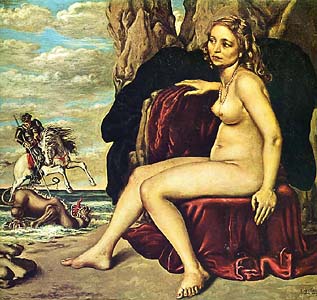 |
| |
Ariadne (1913) |
|
|
St. George Killing the Dragon (1940) |
|
|